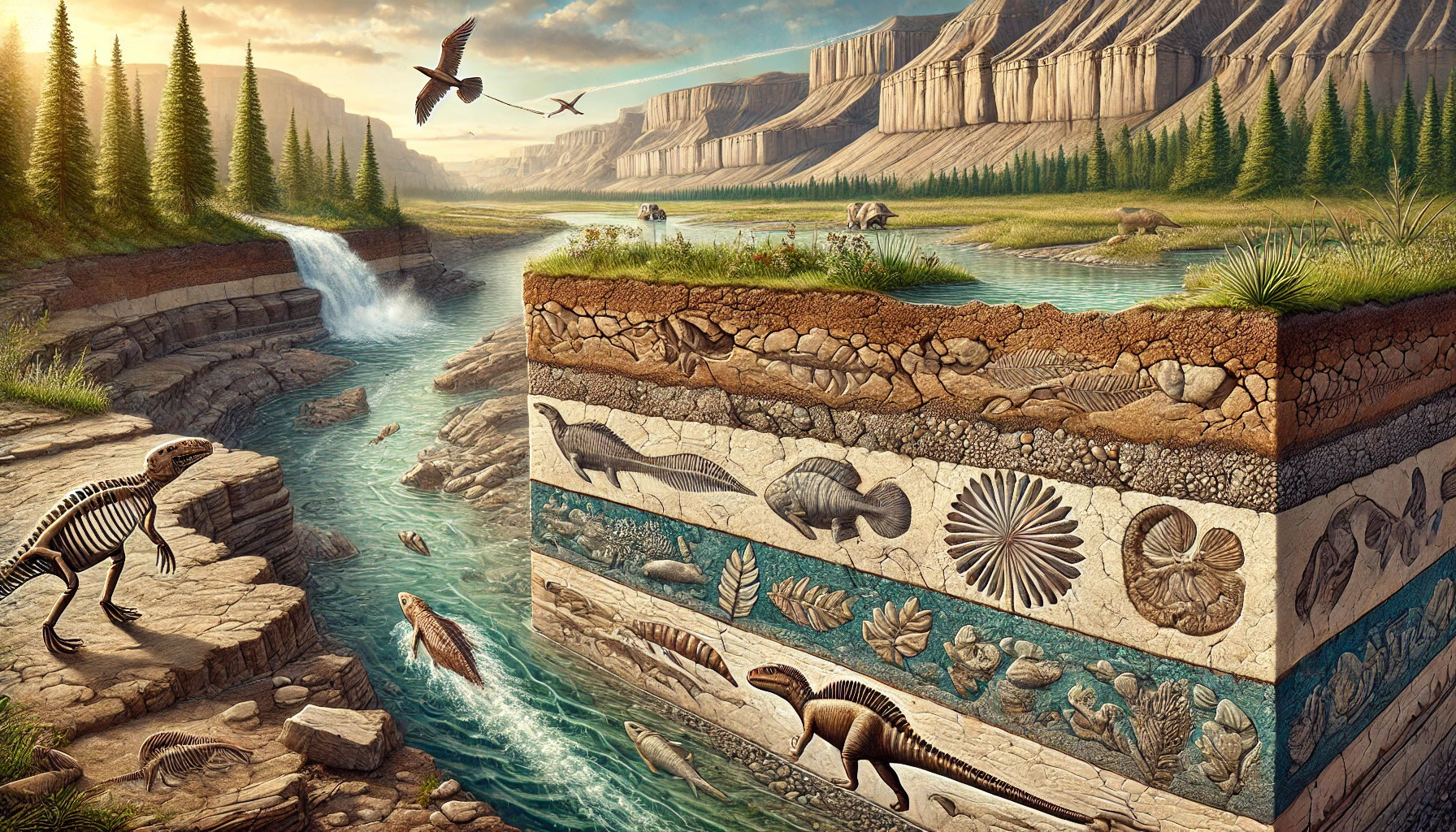Sediment plays a crucial role in the process of rapid fossil burial, which is essential for preserving ancient life forms. The right conditions, including the type and thickness of sediment, allow organisms to be quickly covered and protected from decay. Understanding how sediment influences this process reveals important insights into how fossils form and what conditions are needed for preservation.
When a living organism dies, rapid burial by sediment can prevent it from being exposed to oxygen, which is vital for the decomposition process. Different types of sediments, such as those rich in freshwater, can immobilize specimens, keeping them intact for millions of years. This fascinating interaction between sediment and fossils not only helps scientists piece together Earth’s history but also highlights the delicate balance of environmental factors that contribute to fossilization.
Exploring the role of sediment invites readers into the intriguing world of paleontology. Discovering how these elements work together can deepen appreciation for the preservation of life across geological time. Whether a casual reader or an aspiring scientist, the journey into the science of fossils promises to be enlightening.
Sediment Characteristics and Properties
Sediment plays a crucial role in the burial and preservation of fossils. Understanding its characteristics helps in grasping how different types of sediment influence fossilization processes.
Types of Sediment
Sediment can be classified into several types based on its origin. The main categories are:
- Clastic: Composed of fragments of other rocks and minerals. Common clastic sediments include sandstone and shale.
- Chemical: Formed from precipitation of minerals from water. Examples include limestone and evaporites like salt.
- Biogenic: Originate from the remains of living organisms, such as shells or plant material. Examples are coal and chalk.
Each type plays a unique role in fossil preservation. Clastic sediments often provide a protective layer, while biogenic sediments may contain organic material that contributes to fossil formation.
Sediment Composition
The composition of sediment directly affects its properties and behavior during burial. Clays, silts, and sands are the primary components.
- Clay: Fine particles that compact easily, offering excellent preservation due to their ability to retain moisture.
- Sand: Coarser and allows for better drainage but may not preserve fine details of fossils.
- Silt: Falls between sand and clay and can have both good preservation qualities and some drainage.
The mineral makeup impacts how sediments respond to pressure and time, influencing fossil integrity during and after burial.
Sedimentation Rates
Sedimentation rates are vital in understanding fossil preservation. These rates can vary widely based on environmental conditions.
- Rapid Sedimentation: Occurs during events like floods or volcanic activity, which can quickly bury remains and prevent decay.
- Slow Sedimentation: Allows for decay and disarticulation, which can lead to lost information in the fossil record.
Rates can be measured in millimeters per year. A faster rate enhances preservation chances, while a slower rate may expose fossils to destructive forces longer. Different environments, such as rivers or oceans, can greatly influence these rates, affecting overall fossilization success.
Mechanisms of Fossil Burial
Fossil burial occurs through various processes that help preserve organic remains. Understanding these mechanisms reveals how conditions can favor fossil formation.
Natural Catastrophes
Natural catastrophes, such as floods and volcanic eruptions, can lead to rapid sedimentation. When a flood occurs, it can quickly transport large amounts of sediment. This debris may cover organisms, creating an environment that protects them from decay.
Volcanic eruptions can also contribute to fossil burial. Ash and volcanic material blanket the landscape, entombing plants and animals almost instantly. This rapid cover is crucial for preserving details of the buried organisms, allowing them to fossilize effectively.
Gradual Accumulation
Gradual accumulation happens when sediment builds up over time. This process often occurs in river deltas, lake beds, and ocean floors. As layers of sediment pile on, they can slowly bury organic remains.
The thickness of the sediment layer is essential for effective preservation. Studies indicate that a bed thickness of around 10 cm can help preserve whole skeletons. This slow burial allows for mineral-rich water to percolate through and facilitates fossil formation.
Biogenic Activity
Biogenic activity refers to the role of living organisms in the burial process. When plants and animals die, their remains contribute to sediment buildup. As more organisms die and decay, their organic material enriches the sediment.
This enriched sediment can enhance the conditions for fossilization. For example, mineral-rich environments provide essential minerals that replace organic material over time. This process helps create fossils, ensuring that the remains can last for millions of years.
Fossil Formation Processes
Fossil formation involves several key processes that ensure the preservation of organic materials over long periods. Understanding these processes helps explain how fossils provide insight into Earth’s history.
Permineralization
Permineralization occurs when mineral-rich water permeates the pores of organic remains. Over time, the minerals deposit within these spaces, creating a stone-like structure.
This process often happens in tree trunks, where silica or calcium carbonate replaces the original organic material. The result is a fossilized specimen that retains the structure of the original organism.
Permineralized fossils can reveal details like cellular structures and growth rings. This information helps scientists understand not only the organism itself but also the environment it lived in.
Cast and Mold Formation
Cast and mold formation involves two distinct processes. When an organism becomes buried in sediment, it leaves an impression in the surrounding material, creating a mold.
Later, if the mold fills with mineral-rich water and minerals precipitate, it forms a cast. Casts and molds can show fine details of the organism’s shape and surface texture.
These fossils provide clues about the anatomy and lifestyle of ancient species. They also help researchers reconstruct past ecosystems by showing how different organisms interacted with their environment.
Compression
Compression fossils form when an organism is buried under layers of sediment that exert extreme pressure. This pressure flattens the remains, and over time, they often turn into a thin carbon film.
This film preserves the outline and some details of the organism, allowing for identification. Compression fossils are common in plants and soft-bodied creatures.
They provide valuable information about the conditions in which the organism lived. These details can include aspects like climate, habitat, and even interactions with other species.
Geological Context of Fossil Beds
Fossil beds hold a wealth of information about past environments and life on Earth. Understanding their geological context helps reveal how fossils formed, were preserved, and what conditions existed millions of years ago.
Stratigraphy
Stratigraphy involves studying rock layers, or strata, to understand the sequence of geological events. Each layer can tell a story about the Earth’s history, including changes in climate and ecology.
Fossil beds are often found within these layers, indicating periods of rapid sediment deposition. For instance, a layer rich in fossils might signify a flood event that quickly buried organic materials.
Understanding the stratigraphic position of these beds also aids in dating the fossils, revealing their age in relation to surrounding materials.
Taphonomy
Taphonomy focuses on the processes that affect organic remains from the time of death until discovery. It examines factors like decay, burial, and fossilization.
Key taphonomic processes include how quickly organisms are buried. Rapid burial reduces decay and increases preservation chances. Fossils in sediment-rich environments are often better preserved due to this swift coverage.
Taphonomic studies help interpret the conditions that led to the formation of fossil beds. This can include whether organisms were buried in soft sediment or hard rock layers, affecting their preservation quality.
Paleoenvironmental Reconstruction
Paleoenvironmental reconstruction aims to recreate the ancient ecosystems based on fossil evidence and geological data. This involves analyzing the type of sediment, fossil types, and surrounding geology.
For example, the presence of certain plants or animal fossils can indicate a past environment, such as a swamp or coastal area.
In addition, sediment characteristics, like grain size and composition, provide clues about climate conditions at the time of deposition. This information helps form a clearer picture of the Earth’s historical environments, contributing to a broader understanding of its geological past.
Implications of Rapid Burial
Rapid burial of organisms plays a crucial role in fossilization, impacting various aspects of paleontology and our understanding of ancient life. It provides valuable insights into biodiversity and climate changes over time, serving as a window into Earth’s past.
Significance for Paleontology
Rapid burial is vital for preserving fossils. When organisms are buried quickly, the chances of decay decrease significantly. This process protects the remains from weathering and scavengers, leading to more complete fossil records.
For paleontologists, this means more accurate representations of extinct species. Well-preserved fossils can provide insights into anatomy, behavior, and even the environment of ancient life forms. This knowledge helps reconstruct ecosystems from millions of years ago.
Insights into Past Biodiversity
The fossil record shows the diversity of life at different points in history. Rapid burial captures snapshots of these moments, revealing how species thrived or vanished. Fossils from areas with rapid burial often display a high degree of preservation.
This information is key to understanding evolutionary patterns. Studying these fossils helps scientists learn about species adaptations and extinctions. The fossilized remains serve as a timeline, allowing researchers to trace biodiversity changes through crises and environmental shifts.
Past Climate Indicators
Fossils preserved through rapid burial can also indicate past climate conditions. The type of sediment surrounding the fossils offers clues about the environment they lived in. For example, fine-grained sediments might suggest a calm water setting, while coarse sediments could indicate turbulent conditions.
By analyzing these sediments, scientists can reconstruct ancient climates and weather patterns. This helps in understanding how climate has impacted biodiversity over time. It sheds light on the responses of ecosystems to changing climates, which is valuable in today’s discussions about climate change.

